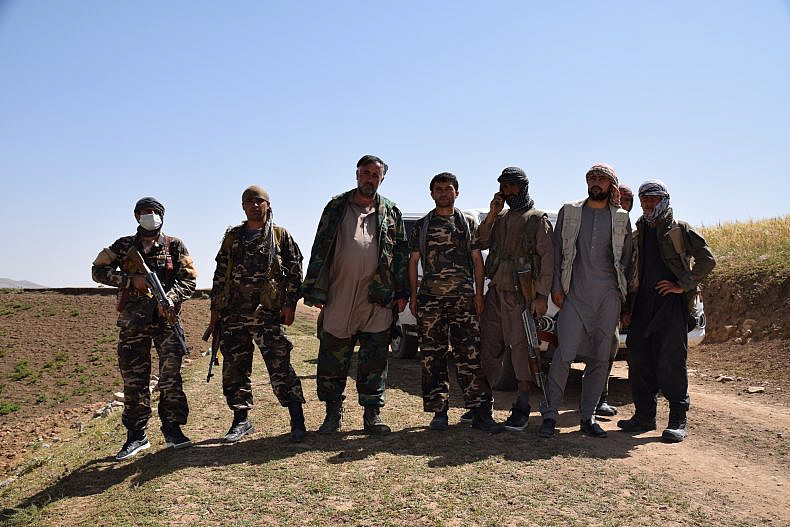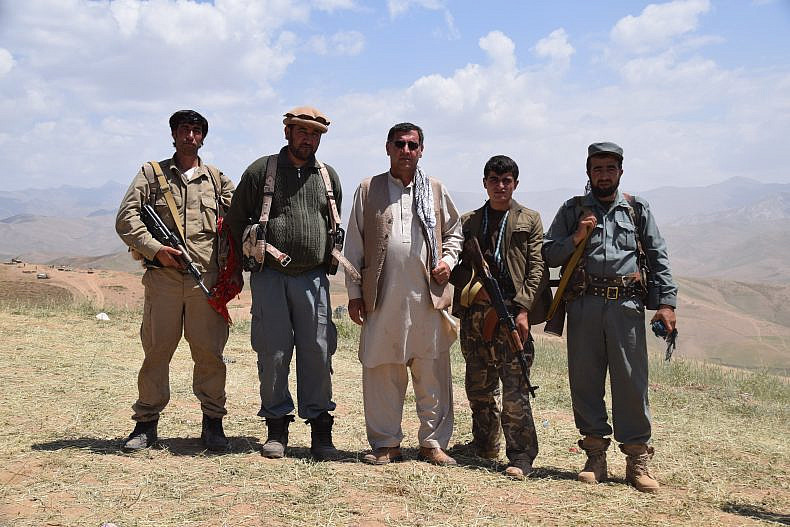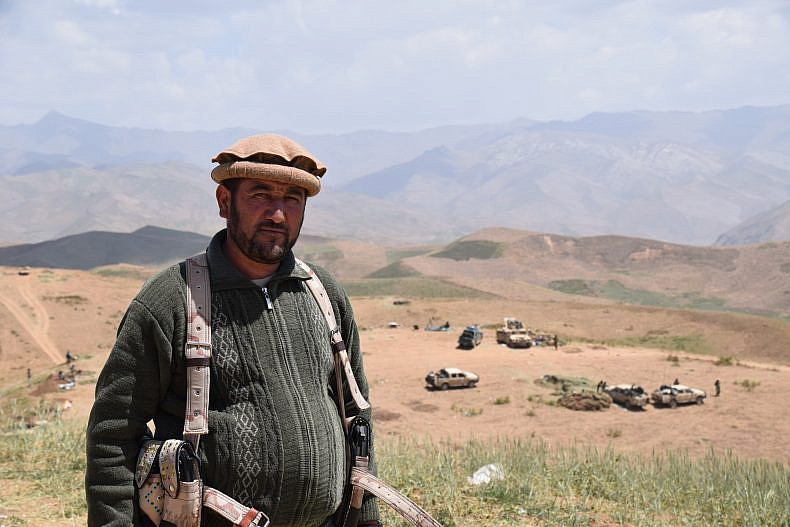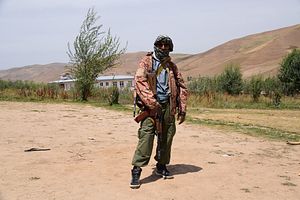ZIRAKI, RAGHISTAN DISTRICT, BADAKHSHAN PROVINCE, AFGHANISTAN — Given the resurgence of the Taliban in Afghanistan, local residents in different parts of the country have – in the absence of sufficient government action against the insurgents – taken up arms to defend themselves. While in some provinces such vigilantes are accused of abuse and harassment, an example in the northeastern province of Badakhshan seemingly had positive effects. But even in this example, the threat of local action undermining the central government, in which the international community has invested and still invests billions of dollars, hovers in the air like an invisible Damoclean sword.
When reportedly hundreds of insurgents attacked Ziraki, the center of the remote district of Raghistan in Afghanistan’s mountainous northeastern province of Badakhshan, at the end of Ramadan in early July, the government — with only 35 to 60 policemen at hand — would have stood no chance. After the Taliban had seized nearly all the hilltops surrounding the small village, located in a valley which gently cuts through a high plateau with meadows and wheat fields, they entered Ziraki itself. The Taliban had already reached the bank of the small mountain river that flows idly through the village and were spreading through half of the bazaar. But a few hundred local men who had taken up arms to defend their families and homes beat off the insurgents, secured the village, and took back the hilltops.
While the heroic stories about the battle of the 27th of Ramadan, as the locals refer to it, might be exaggerated, the sandbag walls at the end of the bazaar as well as bullet holes in houses close to the district governor’s building bear silent testimony that the stories are not made up. And the intermittent sound of distant shooting from the still ongoing fighting on the other side of the hill range that I heard during my visit to Ziraki in early August underscored the recent battle less silently.
Local residents in Ziraki are grateful for the armed uprising and stated that there are no problems at all with the vigilantes. And others, coming from insurgent-controlled nearby areas, expressed their hopes to be soon liberated from the “fire” of Taliban rule, in which they would suffer currently. Given that I was the guest of the uprising’s commander, locals might of course have been reluctant to talk to me about possible issues. But as I stayed for several days in Ziraki and picked up loads of other gossip, I would have probably noticed if there were any major problems between the vigilantes and ordinary civilians. (Obviously, serious issues exist with the locals that make up the vast majority of the insurgents, who violently reject the current government and the uprising that supports it as un-Islamic; but this is another story.)
In view of the fact that all the men of the armed uprisings hail from this or nearby valleys and are, quite literally, protecting their own kin, this might not seem surprising. On the other hand, reports in places like the northern provinces of Kunduz and Faryab accuse local vigilantes of abusive behavior against ordinary residents, ranging from illegal taxation, extortion, and pillaging to beating, rapes, and murder. One explanation as for why such abuses are not heard of in Raghistan is, according to the district governor, that Raghistan and Badakhshan in general – unlike Kunduz or Faryab – are ethnically quite homogenous, with no frictions between the people. However, given that Badakhshan’s population is apparently fractured along political and other lines, which are next to impossible to understand for an outsider, such an explanation does not convince completely.
Be that as it may, there is apparently also no rift between the government and the uprising. The police chief of Badakhshan province, Brigadier General Ghulam Sakhi Ghafoori, even stated that more local government supporters should be armed. And virtually all the vigilantes asserted that they still chiefly back the central government and don’t hold any grudge against it – perhaps surprisingly, in view of the fact that the uprising was initially caused by the failure of the government to defend Raghistan against a growing insurgency. Representative of many, one man (who, with his stocky frame and curly, light brown full beard, looked like a Viking) simply stated his reason for joining the uprising as “I love the government!”

Haiot (third from the left), uprising commander and local head of the Afghan intelligence service, with his men — some official government forces, others vigilantes. Image by Franz J. Marty.
This, of course, does not mean that it is a perfect love story. For example, the main commander of the uprising, Haiot, who like many Afghans goes by only one name, at one point complained that the uprising and the Afghan Local Police, made up of former uprising members, bear the brunt of the fighting, with the central government forces deployed to Raghistan during July allegedly not doing much. Such dissatisfactions do not appear to significantly affect the generally good cooperation between the uprising and the government, though. Similarly, there seem to be no significant differences within the uprising itself, as even an apparently sidelined sub-commander of the uprising who stayed inactive in Ziraki at the beginning of August, was still benevolent toward it. All in all, and to paraphrase district and provincial officials, everyone – official government forces, civil servants, as well as local vigilantes – stand united against the insurgents.
However, even in an apparently positive example of an uprising like in Raghistan, some concerns are hidden beneath the surface. While the uprising is endorsed by the government, this seems to be sometimes more and sometimes less officially the case. Lines begin to blur. For example, Haiot is not only the main commander of the armed uprising, but at the same time also the local head of the National Directorate of Security (NDS), the Afghan intelligence service. It is virtually impossible to tell when Haiot is acting in his function as an official supporting the uprising and when he is more or less privately running it, which he does jointly with his brother Paimon, a member of the national parliament who coordinates things from the capital, Kabul. Local residents and officials did not contest this, but apparently did not see that this might undermine the authority and legitimacy of official government institutions. In fact, for virtually all local residents in Raghistan the blurring between the official government and the uprising was apparently so natural that they did not even seem to grasp the possible issue.
Paimon, the MP, assured me that as soon as the central government provided security, the vigilantes would immediately hand in all their arms. This might well be true. But that is not the sole point, as even then the underlying problem would persist: many people in Raghistan apparently put their trust more in the hands of local power brokers like Haiot than government institutions or the rule of law. Or to illustrate the issue with another example: it is indeed noble that the district attorney of Raghistan, a man with a black beard, tinted glasses, and a turban, stands guard on a outpost on a hilltop with his AK-47 Kalashnikov, whose handle he had decorated with sparkling duct tape. However, the fact that he for now has closed down his office is not only a clear sign of the dire security situation at the moment, but also raises question about the state’s future in such forlorn regions threatened by insurgents.
Ahmad Navid Fouroutan, the spokesman of the governor of Badakhshan province, acknowledged such issues. However, he explained that under the current “exceptional” circumstances, the government needs men like Haiot who wield informal influence due to their status and connections to fight the insurgents. In this regard, he emphasized that the uprisings in Raghistan as well as in other districts of Badakhshan have always cooperated with the government and did not cause any reason to worry. Asked about possible adverse implications for the future, Fouroutan replied that this is unknown, but that it has also to be kept in mind that, if the government refused to cooperate with such vigilantes now, they might not only turn against the insurgency, but also against the government. The simple truth is probably that the government needs the uprisings at the moment and does not have the luxury to think about the future.

Men fighting the Taliban — some vigilantes, some vigilantes turned into Afghan Local Police and one member of the Afghan National Police. Image by Franz J. Marty.
To counter concerns about armed groups outside of the official system, the central government tries to incorporate them into its ranks. This is nothing new, in fact. Already back in 2010, the Afghan Local Police was established to provide an official framework for villagers defending their own turf. And to cope with a more recent surge of uprisings in different parts of the country, the government created the so-called People’s Uprising Program in August 2015. Information on the secretive program remains scarce, but it reportedly originated in countering the emergence of the so-called Islamic State in eastern Afghanistan with local uprisings. The program is said to be under the auspices of the Independent Directorate of Local Governance (IDLG), a ministerial-level body that oversees provincial governments, but is also funded and supported by the NDS.
While around 100 vigilantes from Raghistan indeed were converted into an official unit of the Afghan Local Police sometime in early 2016, it remains unclear to what extent the uprising there is part of the People’s Uprising Program. Various sources in Raghistan insisted that the uprising is and has always been endorsed by the government and receives support from the NDS and/or the National Security Council (NSC), but this could not be confirmed, as – despite efforts – neither the NDS chief of the province of Badakhshan nor responsible officials from the IDLG, the NDS, or the NSC in Kabul could be reached for comment.
What can be said, though, is that those efforts to blend independent actors and the government are not going that smoothly. Odam Khan, the commander of the Afghan Local Police in Raghistan, stated that his unit, while getting some support such as ammunition, lacks other necessary equipment, in particular cars and motorcycles to move around. He and other sources further stated that local officials since months want to incorporate more uprising fighters into the Afghan Local Police in Raghistan, but that they don’t receive any reply from the provincial or national authorities. While the district governor of Raghistan described this as mere teething troubles and Fouroutan asserted on August 10 that a plan to increase the Afghan Local Police throughout the province by 500 men has been approved by Kabul and is in the making, one member of the Afghan Local Police in Raghistan proclaimed in exasperation that, if the government has not been able to solve the issues during the past several months, it will never be able to do it.

Odam Khan, commander of the Afghan Local Police and former vigilante, on the frontline. Image by Franz J. Marty.
On the other hand, there are no details available as to exactly what kind of support the uprising itself receives from the government. However, sources agreed that sometimes there would be government support, such as weapons or salaries, and sometimes not — or at least not sufficiently. But whenever the government support is insufficient, Haiot and Paimon would take care of it, Haiot himself as well as other sources stated. One source even openly acknowledged that the needed weapons and ammunition are then bought from black markets inside Afghanistan. Given that it is not a far stretch to imagine that those are the very same black markets that the insurgents use to resupply, this is another questionable aspect of the local vigilantes.
In the end, it is hard, if not impossible, to tell if such local armed uprisings are overall a curse or a blessing for the government, in particular as they seem indeed to range from the blessing of true and noble local resistance to the curse of abusive private militias. In any event, such uprisings are a reality that the central government has to cope with somehow. The problem, then, is how to meaningfully incorporate or abolish them. Because even in the case of an apparently positive uprising like in Raghistan, the mere existence of an armed group outside the official system by its very nature threatens the foundation of every state – its monopoly on executing force to uphold order. So while the uprising in Raghistan is most probably more blessing than curse, it is a blessing with at least a grain of salt.
In any event, given that sometime in mid- to late August virtually all official government forces have reportedly been redeployed from Raghistan to other parts of the country — leaving the insurgents, who still hold some of their main positions in Raghistan, weakened but not defeated — the locals have little choice but to fight for themselves.
Franz J. Marty is a freelance journalist based in Kabul, Afghanistan. He writes mainly on security and military issues and can be followed @franzjmarty on twitter.
































